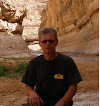The Journey: La Paz – Coroico – La Paz.

A couple of paragraphs from Wikipedia :
The North Yungas Road (alternatively known as Grove's Road, Coroico Road, Camino de las Yungas, Road of fate or Death Road) is a 61-kilometre (38 mi) or 69-kilometre (43 mi) road leading from La Paz to Coroico, 56 kilometres northeast of La Paz in the Yungas region of Bolivia.
It is legendary for its extreme danger and in 1995 the Inter-American Development Bank christened it as the "world's most dangerous road". One estimate is that 200 to 300 travellers are killed yearly along the road. The road includes cross markings on many of the spots where vehicles have fallen.


This road is one of the few ones that connects the capital of La Paz with Amazon rain forest, or Yungase region. After La Paz, the road first runs up to 4650 m (La Cumbre Pass), and then descends to 1,200 meters. Most of the road is a single line road, the width is 3.2 meters, and there are no borders.

Due to the dangerous issues there is only left-side traffic on the old part of the Death Road , and as the upgoing vehicle has the privilege, the descender has to keep to the left as much as possible.. Due to driving on the left , the driver can better see how far to the left edge of the road it is still safe to drive.


ˇThe road of North Yungas was built in the year of 1930 , when there was a war between Bolivia and Paraguay (Chaco War), and the builders were Paraguayan prisoners of war.

" Built " is , of course, a general expression , a more accurate expression of many passages would be " cut the road into a rock wall ."
I honestly cannot remember exactly when I first learned about the Bolivian Death Road . But I remembered images of a narrow gravel road , running on a steep hillside through the tropical rain forest . Further searches provided with more pictures and more info . That the road is in Bolivia , near the capital, and that the most dangerous part ( this can be avoided by driving to Coroico along a new asphalt road built in the opposite side of the valley )is still there .
In short- North Yungas has been for many years on my list of " obligatory visits to important places ," and now The Moment has finally arrived.

And it is written in several sources that the road is foggy most of the time, and the visibility is quite poor. This story is absolutely correct, the above picture is the upper part of the road.

Driving along the new road towards Coroico - sometimes for a few moments, one can see the old road on the other side of the valley.
The plan was to arrive at the end of the old road of Coroiko`side , and there was supposed to be by the road a completely ok overnight place.

Morning at the beginning of the road of Yungas .
At 7 a.m. someone local pounded on my bus and asked whether I was going downhill to Coroico , but I could not gladden him, as the journey went on to the other side.

The sky is cloudy, fortunately it was not raining.





In the meantime - a local ranger , rescue service.

Meanwhile at times, a slight breeze is blowing the clouds wide apart and the bottom of the valley comes visible. The weather is changing not even with every hour, but minute by minute. For a minute the sky is clear, and in a second it is cloudy again.

But all these clouds and fog belong to the scene, otherwise it isn`t the famous North Yungas Road.



Then, the traffic is turning denser, because the riskeness of the road has made it a tourist magnet.

Local tour companies advertise the opportunity to ride a bike down the hill along Death Road . And so - a dozen or so of cyclistss are coming, followed by a couple of minibuses. And then the next group and the next. Looks like that is a popular attraction , although according to different sources - at least 18 cyclists have got killed around here since 1988.

The cyclists are followed by slowly moving local Toyota minivans. Every day they bring cyclists to the beginning of the road of La Paz, and drive through all the route.

I am driving on.

For a moment the sun appears from behind the clouds and illuminates the hillside and the road.


Some curves are foggier ....

And some even more foggier.



A moment ago, the road was still visible ....


A few more risings , and before crossing the big road there is a buildng - bus stop / viewpoint by the road . The weather is cloudy again .

A little bit of waiting and the covered road can be seen from afar . In total, it took 5 hours together with countless stops . You make a stop, take some pictures, then erase them, take some more – even foggier and grayer and try to find a better place. In the „better place“ the visibility . is hardly 5 meters.
And, of course, one must look for a safe place to park the car. So you go back and forth looking for a better spot and meanwhile, having climbed on the roof of the car - you discover that the camera, that had been fixed to the roof of the rack, is no longer working, the batteryies empty .etc etc.
So these 5 hours were spent.

But the main thing is - the legend - "World 's Most Dangerous Road" has been driven through, undergone and experienced .



No comments:
Post a Comment